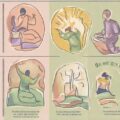Understanding Historic Trauma in Indigenous Communities
Historic trauma refers to the collective emotional and psychological injury experienced by a group of people over generations. For Indigenous communities worldwide, this trauma stems from a long history of colonization, forced assimilation, and cultural genocide. The effects of this trauma continue to impact Indigenous individuals and communities today, manifesting in various health disparities and social challenges.
However, there is hope and healing to be found in traditional Indigenous practices and wisdom. By reconnecting with ancestral knowledge and cultural traditions, many Indigenous people are finding powerful ways to overcome historic trauma and promote wellbeing for themselves and future generations.
The Power of Traditional Healing Ceremonies
Across Indigenous cultures, traditional ceremonies play a vital role in healing and restoring balance. These sacred rituals often involve:
- Connection with nature and the spirit world
- Use of medicinal plants and herbs
- Rhythmic drumming and singing
- Purification practices like sweat lodges
- Community gathering and shared intention
By participating in these time-honored ceremonies, Indigenous people can reconnect with their cultural identity, find a sense of belonging, and begin to heal deep-seated traumas. The power of ceremony lies not just in the rituals themselves, but in the sense of continuity and resilience they represent.
Embracing Traditional Knowledge and Wisdom
Indigenous healing is deeply rooted in traditional ecological knowledge and holistic worldviews. This ancestral wisdom offers valuable insights for addressing trauma and promoting wellbeing:
- Understanding the interconnectedness of all living things
- Respecting the balance between mind, body, spirit, and environment
- Emphasizing prevention and whole-person care
- Utilizing natural medicines and healing practices
- Honoring the wisdom of elders and ancestral teachings
By embracing these traditional approaches, Indigenous communities are reclaiming their health and cultural identity. This return to ancestral wisdom is not only healing for individuals but also helps to preserve and revitalize endangered cultural knowledge.
The Role of Community and Cultural Connection
Healing from historic trauma is not just an individual journey, but a collective one. Strong community bonds and cultural connection play a crucial role in Indigenous healing practices. Some ways this manifests include:
- Intergenerational healing circles and talking circles
- Community-led health and wellness initiatives
- Cultural revitalization programs and language preservation efforts
- Land-based healing programs reconnecting people with traditional territories
- Mentorship programs pairing elders with youth
These community-centered approaches help to rebuild the social fabric that was disrupted by colonization and forced assimilation. By coming together in healing, Indigenous people find strength, support, and a renewed sense of cultural pride.
Integrating Traditional and Modern Approaches
While traditional practices form the foundation of Indigenous healing, many communities are also finding value in integrating modern therapeutic approaches. This blended approach can include:
- Culturally-adapted cognitive behavioral therapy
- Trauma-informed care that incorporates Indigenous worldviews
- Substance abuse treatment programs rooted in cultural practices
- Mental health support that respects traditional beliefs and practices
- Research partnerships between Indigenous communities and health institutions
By combining the strengths of both traditional and contemporary approaches, Indigenous communities can address the complex layers of historic trauma while honoring their cultural heritage.
Empowering Future Generations
Healing from historic trauma is not just about addressing the past, but also about creating a stronger future. Many Indigenous healing initiatives focus on empowering youth and breaking the cycle of intergenerational trauma. This can involve:
- Cultural education programs in schools
- Youth leadership development focused on cultural pride and resilience
- Intergenerational storytelling and knowledge sharing
- Programs supporting healthy parenting and family bonding
- Opportunities for youth to participate in traditional practices and ceremonies
By investing in the wellbeing and cultural connection of younger generations, Indigenous communities are building resilience and hope for the future.
Frequently Asked Questions
What is historic trauma?
Historic trauma refers to the cumulative emotional and psychological wounding experienced by a group of people over generations. For Indigenous peoples, this often stems from colonization, forced assimilation, and cultural loss.
How do traditional healing practices help with trauma?
Traditional healing practices can help by reconnecting individuals with their cultural identity, providing a sense of belonging, and offering holistic approaches to mental, emotional, and spiritual wellbeing.
Can non-Indigenous people benefit from these healing practices?
While these practices are rooted in Indigenous cultures, many of the underlying principles of holistic healing and connection with nature can be beneficial for anyone. However, it’s important to engage respectfully and not appropriate sacred practices.
How can I support Indigenous healing initiatives?
You can support by educating yourself about Indigenous history and issues, advocating for Indigenous rights and land protection, and supporting Indigenous-led organizations and healing programs.
Are these traditional practices scientifically proven?
While not all traditional practices have been studied through a Western scientific lens, many have shown positive outcomes in community-based research. The holistic nature of these approaches often addresses aspects of wellbeing that are overlooked in conventional medicine.
In conclusion, Indigenous healing practices offer powerful ways to address historic trauma and promote wellbeing. By honoring traditional wisdom, fostering community connections, and empowering future generations, Indigenous peoples are reclaiming their health and cultural identity. This journey of healing not only benefits Indigenous communities but also offers valuable insights for all of humanity in our collective quest for balance, resilience, and harmony with the natural world.









